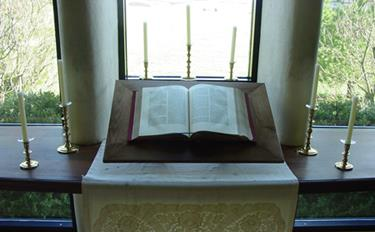Sunday Worship
What Spiritual States do our Rituals Represent?
Why do we stand and sit?
And He went into the synagogue on the Sabbath day, and stood up to read…. And having closed the book, He gave it back to the officer, and sat down. (Luke 4:16, 20)
AC 9422:2. Movements from place to place signify changes of state of the interiors… Consequently “sitting” signifies remaining permanently in the state of the interiors. Because “sitting” has such a signification, therefore to sit was one of the rituals received among the sons of Israel when they represented a permanent state of the interiors….
AR 366. Standing before the throne, and before the Lamb, signifies hearing the Lord, and doing what He commands. By “standing before God” is signified to hear and do what He commands, as he who stands before a king….
Why do we make an offering?
Take from among you an offering unto Jehovah: whoever is of a willing heart, let him bring it, an offering to Jehovah. (Exodus 35:5)
AC 5619. …The presents they gave [to judges and kings] represented such things in man as ought to be offered to the Lord when He is approached, which are things that are from freedom, consequently from the man himself…. From this it is that a present should be given by man to the Lord on approaching Him.
AC 4262:3. …As [giving a present] was a holy ritual, signifying initiation, the wise men from the east also, who came to Jesus just after His birth, brought presents….
Why do we have a sermon?
CL 24. When the congregation [in heaven] was assembled, the priest ascended the pulpit and preached a sermon full of the spirit of wisdom. Its subject was the holiness of the Sacred Scripture, and the conjunction, by its means, of the Lord with both worlds, the spiritual and the natural. In the enlightenment in which he was, he fully proved that this Holy Book was dictated by Jehovah, the Lord; and that hence He is in it, even so that He is the wisdom in it; but that the wisdom, which is Himself in it, lies concealed beneath the sense of the letter, and is opened only to those who are in truths of doctrine and at the same time in goods of life, and so are in the Lord and the Lord in them. To the sermon he added a reverent prayer, and then descended.
Why does the priest wear a robe?
And I turned to see the voice that spoke with me; and, having turned, I saw seven golden lampstands, and in the midst of the seven lampstands One like the Son of Man, wearing a garment down to the foot, and girded around the breast with a golden belt. Revelation 1:12–13
AR 167. In the Word, “white” is predicated of truths, because it draws its origin from the light of the sun….
AR 46, 913. A “belt” in the Word, also signifies the common bond, by which all things are held together in order and connection…. “Gold” from correspondence signifies the good of love.
AE 951:7. …Man has communication with the societies of heaven by means of his garments; and there are societies that are in good and societies that are in truth… It has been granted me to know this from changing my garments. For when I have laid aside a linen garment, those in the spiritual world who were in truths have complained that they could not be present; and when I again put on the garment, the same spirits became present. That there is such correspondence with the very garments of man… can be seen… from what is said of the linen garments of Aaron and his sons, the linen ephod that the priests and David wore, the linen in which the angels appeared clothed, and the linen cloth with which the Lord girded Himself and wiped the disciples’ feet, also the other garments of Aaron and his sons, all of which were representative; also from the signification of garments in general, as being truths clothing good.
Points to Consider
- Sitting corresponds to a permanent state, and also to a state of tranquility (AC 3552), and the life of man’s will (AE 387:5). Standing corresponds to being ready to act in response to the Lord’s directions. Do you sometimes feel these correspondences in sitting and standing?
- Making an offering on approaching the Lord can be the first step in worshiping Him. But some people find it hard to associate putting money in the basket with, for example, the wise men presenting their gifts, signifying love to Him, faith in Him, and obedience to Him. Can we pray that our offerings may have this correspondence? Does it help to remember that our offerings of every kind (our work, thought and affection) are in essence gifts from the Lord to us? (See AC 9938:2.)
- What can we learn from this one example of a sermon in heaven?
- One purpose of a priest’s robe is to draw attention away from the person of the priest to the Lord. Uniforms of many kinds have a similar purpose, to focus on the office or use rather than the person.
- In Revelation, the Lord’s belt was around His chest. In Daniel 10, the Lord appeared with a golden belt around His loins (verse 5).
- Closing the Word at the end of the service does not mean that the Lord has left us, but that the representation of His coming is finished for now. Some churches leave the Word open, but then we would have to turn our backs on it when we leave, and it would make less sense to begin our service with opening the Word.
| previous |  |
next |
|---|


